 Leading Blog | Posts by Month |
 Leading Blog | Posts by Month |
08.31.21

LeadershipNow 140: August 2021 Compilation
See more on
Posted by Michael McKinney at 07:45 AM
08.30.21

Made From Scratch
THE KIND OF SUCCESS Texas Roadhouse has enjoyed didn’t happen by doing things the conventional way. But then founder Kent Taylor is not a conventional guy. He dropped out of business school and threw away the rule book. Through trial and error and a whole lot of perseverance, he opened the first Texas Roadhouse in 1993. He describes Texas Roadhouse as “a people company that just happened to sell steaks.” In 1997 he was awarded an Emerging Entrepreneur of the Year. Regarding that occasion, he said that his “emerging” took him thirteen years “from idea to rejection, from success to failure, and finally from failure to a glimmer of success.” His story is told in Made from Scratch. It is a well-written story that takes us from his days as a student-athlete through his formative years working his way up in bars and restaurants from busboy to manager, to the wild ride founding and growing Texas Roadhouse into the international success it is today. In 1997 he was awarded an Emerging Entrepreneur of the Year. Regarding that occasion, he said that his “emerging” took him thirteen years “from idea to rejection, from success to failure, and finally from failure to a glimmer of success.” Throughout the book, his colleagues, friends, and family members weigh in on Taylor’s remarkable journey, and at the end of each chapter, he summarizes lessons he had learned along the way. It is a great mix of the lessons, the mistakes, the rejections, personal growth, and the counterintuitive ideas that worked. Some of the lessons Taylor shares are: There’s a perception that we can’t do much about our weaknesses in life, so we should only focus on our strengths. That’s BS. We can often get better at something if we love it and are willing to put in the work (running, in my case). In some cases, we can even become outstanding. Weaknesses can become our strengths. 
Posted by Michael McKinney at 09:09 AM
08.26.21

Leading Thoughts for August 26, 2021
IDEAS shared have the power to expand perspectives, change thinking, and move lives. Here are two ideas for the curious mind to engage with: French political philosopher and historian Alexis De Tocqueville on what democratic nations have to fear: “I have no fear that they will meet with tyrants in their rulers but rather with guardians. Such a power does not destroy, but it prevents existence; it does not tyrannize, but it compresses, enervates, extinguishes, and stupefies a people, till each nation is reduced to nothing better than a flock of timid and industrious animals, of which the government is the shepherd.” Source: Democracy in America Volume 2, Fourth Book Former British Prime Minister Margaret Thatcher on the need for prudence or commonsense: “Of the four cardinal virtues — courage, temperance, justice, and prudence — it is the last — prudence — that the ancient philosophers traditionally placed at the moral apex. They did so because they understood, quite rightly, that without that practical, seemingly rather dull, virtue none of the others could be correctly applied. You have to know when and how to be brave, or self-controlled or fair-minded, in particular situations. Prudence — or what I would prefer to call a good, hearty helping of commonsense, shows the way.” Source: Ronald Reagan: The Greatness of His Achievements, Speech delivered to The Heritage Foundation’s 25th Aniversary, December 10, 1997 Look for these ideas every Thursday on the Leading Blog. Find more ideas on the LeadingThoughts index.
Posted by Michael McKinney at 12:51 AM
08.23.21

Timeless Leadership Lessons I Learned from My First Job as a Swim Instructor
THERE’S something about our first jobs that stick with us. They teach us things we didn’t expect to learn and shape the person we become later in our professional lives. This phenomenon happens even when that first job has absolutely nothing to do with the career you ultimately end up pursuing, which is exactly what happened to me. I was 14 when I first started as a lifeguard and swim instructor at my hometown pool in Canton, Connecticut. I got the position despite an awkward first interview: an inexperienced teenager – I simply wasn’t prepared for the questions they asked. What would you say are your greatest strengths and weaknesses? Where do you see yourself in five years? I didn’t know. But they gave me the job anyway. And in the months that followed, I learned some important lessons that guide me in my work life even to this day as a healthcare executive. Here are three of the most important ones: Lesson 1: Don’t Force It As a swim instructor, I quickly learned that moving at the student’s pace - moving into the pool one step at a time, taking small steps - or strokes - instead of telling them to jump into the deep end right off the bat, or worse yet forcing them into the water when they were not ready, creates much better results. Using the baby step approach develops students who are comfortable and who, instead of being so paralyzed with fear that they can’t move, feel ready to learn. Breaking lessons into smaller, more manageable goals - like reaching underwater for the penny on the stairs first and then submerging their heads in the shallow end second - actually increased my students’ rates of improvement because they could move to the next level with confidence. While each staff member may learn at a different pace, slow and steady progression in their individual roles is beneficial to all. Creating manageable and immediate goals - all of which may lead to the accomplishment of a larger goal - makes for a confident worker who enjoys learning new things and growing and tends to stay in their job or at the company longer. Lesson 2: Making it Fun Makes a Difference In swimming class, making lessons fun is easy: “Let’s see who can splash the most water out of the pool by kicking their legs as straight as possible!” almost always works with kids. And while they are busy having fun, they’re also improving an essential skill for their swimming. Not everything can be fun all the time – we call it work for a reason – but finding ways to turn trainings into games, holding a competition for the best way to improve a work process, or giving monthly employee of the month awards are all ways to reward staff for a job well done. No matter our age, we all enjoy playing, and making training enjoyable can create professionals who have perfected skills that will be essential for more serious situations. Lesson 3: Persistence Pays Off Anyone who has ever coached or taught knows the incredible satisfaction that comes from watching a student or athlete achieve a goal. As a swim instructor, watching the child who was scared to even step into the shallow end of the pool finally jump off the diving board was as rewarding for me as it was for the swimmer. One of my greatest managerial joys is seeing a LinkedIn posting about a new position or reading a healthcare publication article about some new company’s success and realizing that I am reading about one of my former employees. Our greatest success as managers is seeing those we mentored succeed themselves.  A lot has changed in the world of work since that summer, but the leadership lessons I learned giving swim classes at the pool in 1977 are as timeless as that vintage magazine cover. 
Posted by Michael McKinney at 08:10 AM
08.20.21

The Story of U.S. Business Is the Story of Real Estate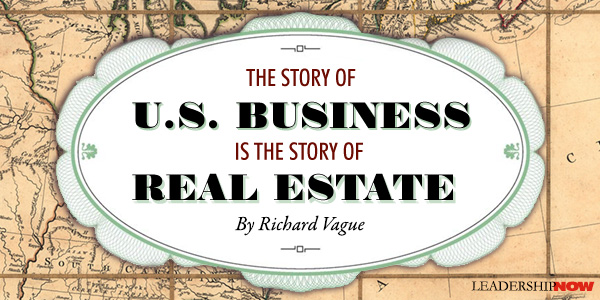
THE STORY of American business is the story of real estate — a story of more than 200 years of claiming, seizing, developing, settling, and speculating in vast areas of land. Even though business histories often give more attention to the history of the manufacturing industry, real estate has been the more dominant factor. Wealthy colonials organized massive land companies well before the American Revolution. Land had been the source of power and wealth in the Old World, and so for Europeans, the vast acreage of the New World held great promise, whether for farming, housing, or other ends. The early colonial years included land charters and grants, such as those to William Penn and George Calvert, but these often went to absentee landlords. From the outset, ambitious American colonists well understood that buying land and waiting for the population to increase was a path to riches. Dating the beginning of true American business correlates not to the first mills or manufactories but to the Ohio Company of Virginia, which was formed in 1748 to acquire hundreds of thousands of acres of land. Many of its shareholders and administrators — Virginia’s elite, including George Washington — were born on American soil. The American Revolution itself was in large part about land, as land speculators including Washington and Patrick Henry bristled under edicts imposed on colonists in 1763 and 1773 that restricted their ability to buy and settle on lands west of the Appalachians. Rights to the land instead were reserved for others, such as the wealthy in England. Since then, the history of American business has had as one of its key elements an unbroken march of real estate speculators and developers, from Robert Morris and William Bingham to John Jacob Astor, Fred French, Eli Broad, Trammell Crow, and many more. At $60 trillion in 2019, real estate was the single highest-value asset in the United States, greater than the value of stocks, bonds, or any other major asset category. Yet extensive as it is, real estate is a hidden giant. It’s always had much broader ownership than most other large-scale businesses, with a higher number of smaller concerns, and doesn’t lend itself as readily to conventional corporate and public equity structures. So, although massive, real estate hasn’t shown up as prominently on the lists of the largest businesses, industries, and wealthiest individuals that shape our economic imagination. With America’s Industrial Revolution in the 1800s, infant mortality fell, life spans increased, and the country saw an unprecedented explosion in population growth — and the real estate business does very well when the population grows rapidly. More people meant more buyers. Owning and improving land necessitated getting to that land, and so a booming real estate enterprise led to America’s transportation industry. This history threads through the centuries, from the earliest toll road and canal companies to the almost century-long, tumultuous domination of the railroad industry to the 20th-century network of roads and highways to serve the automobile revolution. The mammoth steel, coal, and petroleum industries that tower over U.S. business history can be interpreted as suppliers to the transportation industry. Alongside this came the financiers that supplied the funds to make it all possible. Real estate was the base of the economy. The country spent billions to build canals, railroads, and highways, but the money spent to buy and develop the surrounding real estate — the homes, offices, retail, and farms in the land surrounding these new transportation arteries — exceeded even that amount. The future of America’s real estate industry will follow a similar course: 1. Real estate developers will capitalize on infrastructure investment. The paradigm played out through the history of real estate speculation attaching itself to expansions in transportation applies to today’s infrastructure legislation. As infrastructure is built, modernized, and expanded, the spaces contingent on the public infrastructure investment will yield private wealth through real estate. 2. Commercial real estate will profit even as it transforms. The COVID pandemic has brought talk of office buildings — and even the cities that aggregate them — going obsolete. Others have predicted that, with the explosion of intangible, virtual “space,” the tangible space of land and commercial real estate will lose importance. But even with this, real estate continues to be a dominant factor. Virtual commerce still relies on actual land. Companies such as Amazon and Google gobble up acres of land for their warehouses and server farms, and the growing roster of such futuristic businesses as genetic engineering firms seize new buildings with specialized labs designed for their work. No matter what the future may bring, real estate will remain a dominant part of the story of business in the U.S.  
Posted by Michael McKinney at 07:31 AM
08.19.21

Leading Thoughts for August 19, 2021
IDEAS shared have the power to expand perspectives, change thinking, and move lives. Here are two ideas for the curious mind to engage with: April Rinne on how to thrive in a fast-paced world: “In an upside-down world that coaxes, cajoles, and coerces you to run ever faster, your key to true success and growth is to do the opposite: learn how to run slower. Source: Flux: 8 Superpowers for Thriving in Constant Change American educational philosopher Robert Maynard Hutchins, former chancellor of the University of Chicago, with a timely comment on a return to critical thought: “As the Renaissance could accuse the Middle Ages of being rich in principles and poor in facts, we are now entitled to inquire whether we are not rich in facts and poor in principles. Our bewilderment has resulted from our notion that salvation depends on information. The remedy may be a return to the process of rational thought.” Source: Robert Maynard Hutchins, Convocation Address 1933 Look for these ideas every Thursday on the Leading Blog. Find more ideas on the LeadingThoughts index.
Posted by Michael McKinney at 07:37 AM
08.16.21

15 Attributes of Positively Energizing Leaders
WHEN YOU HEAR the term positive leadership, it is easy to get cynical and think it is all happy-talk and disconnected from reality. But it isn’t. In fact, it is about those attributes that energize us and help us to deal with reality in a productive way. In Positively Energizing Leadership, Professor of Management and Organizations at the Ross School of Business at the University of Michigan, Kim Cameron, says it is about “how to capitalize on an inherent tendency in all living systems to orient themselves toward light or life-giving positive energy. It is known as the heliotropic effect. It is a “concept adapted from a phenomenon typically ascribed to how plants respond to the sun’s rays.” Cameron applies it here to the social and organizational sciences. “The kind of positive energy that most accounts for flourishing in individuals and in organizations is called relational energy.” Relational energy is brought to you by virtuous actions like generosity, compassion, gratitude, trustworthiness, forgiveness, and kindness. Mandating that employees behave positively, think happy thoughts, or be cheerful when they are depressed, anxious, or experiencing emotional pain produces false positivity. It is inauthentic, disingenuous, dishonest, and untrustworthy. It denies reality, which is the opposite of virtuous responses in trying times. It is these virtuous responses that build the relational energy that moves an organization forward in good and bad times. It is real, and we naturally respond positively to them—the heliotropic effect. Importantly, these demonstrated behaviors “lead to the only kind of energy that does not deplete with use and does not require recovery time after it is expended. Whereas physical, emotional, and mental energy diminishes with use, relational energy elevates. There are 15 attributes associated with positively energizing leaders: 1. Help other people flourish without expecting a payback. Positive energizing is not transactional. “A quid pro quo is not expected.” They contribute for the benefit of others without concern for who gets the credit. 2. Express gratitude and humility. Humility makes possible to put the spotlight on others and expressing gratitude for their contribution early and often. Humility also means graciously accepting feedback. 3. Instill confidence and self-efficacy in others. They know how to build confidence in others by acknowledging their strengths. They assist when others fall short. They also create opportunities for others to be acknowledged for their successes. 4. Frequently smile. A smile is often overlooked, but it goes a long way. In repose, we sometimes look angry or sad. A leader should always be mindful of the emotion they are communicating. Put on a smile. 5. Forgive weaknesses. Cary Nieuwhof once wrote, “Be the type of friend that fixes a friend’s crown without telling them it’s crooked.” Positively energizing leaders forgive and turn mistakes and failures into learning experiences. 6. Are personal and know outside-of-work interests. Understanding that the whole person comes to work, positively energizing leaders invest the time to get to know the whole person – family, interests, and goals. “A study at the University of Kansas found that it takes about 50 hours of socializing to progress from an acquaintance to a ‘casual’ friend, an additional 40 hours to become a ‘real’ friend, and a total of 200 hours to become a close friend.” 7. Share plum assignments and recognize others’ involvement. Rather than keeping the best assignments for themselves, “they find ways to involve others, to help them find ways to succeed, and to be acknowledged. They are willing to share the limelight without abrogating their own responsibility to lead.” 8. Listen actively and empathically. They consciously do not dominate the conversation and share their ideas. They listen and ask questions giving others the opportunity to share. They respond compassionately when necessary. 9. Solve problems rather than create problems. They anticipate the needs of others and potential problems and respond rather than always reacting. “They take responsibility for generating results.” 10. Mostly see opportunities. They possess a realistic optimism. They find a way forward through problems rather than getting bogged down in the moment. They are hopeful. “They approach challenges and difficulties with a ‘yes, and’ rather than a ‘yeah, but.’” 11. Tend to inspire and provide meaning. They have clarity. They know why we are doing what we are doing and inspire others to see their part and impact in the bigger picture. “They elevate others’ views.” 12. Are trusting and trustworthy. They are trusted to do what they say they will do and behave in alignment with their stated values. They also build trust by being trusting. 13. Are genuine and authentic. Their positivity is genuine and not an act. It is derived from who they are. When appropriate, they share their personal challenges and mistakes to encourage others to move forward. 14. Expect very high performance standards. Never satisfied with good enough, they help other to exceed the basic requirements and help them achieve beyond what they thought possible. 15. Mobilize positive energizers who can motivate others. They seek out other positively oriented people and mobilize them to uplift others and create a positive work environment. “They marshal positive energizers to foster improvement and goal accomplishment. Few people possess all of these attributes, but everyone can develop them. In Cameron’s research, all 15 attributes contributed to positive outcomes, but the last 5 (11 through 15) were “especially powerful predictors of organizational success.” These findings highlight the fact that positively energizing leaders do not need to display superhuman attributes. They are individuals who simply display behaviors that we all admire: inspiring others, show integrity, and being genuine. They expect us to be better. And they involve others in accomplishing desired outcomes. As a result, the organizations they lead perform significantly better than industry averages. Cameron provides specific ideas on how to develop these attributes and examples of energizing leadership and its impact on organizational performance. When people are struggling or going through difficult times, putting on a happy face is not the answer. Instead, Cameron suggests that we “focus less on cheerfulness, positive thinking, and unbridled optimism” and emphasize “demonstrating virtuousness. Virtuous behaviors—including gratitude, humility, kindness, generosity, contribution, forgiveness, compassion, trust, and integrity—are heliotropic and lead to positive energy and thriving, especially in difficult times.”  
Posted by Michael McKinney at 10:10 AM
08.13.21

The Courage to Lead with Character and Resiliency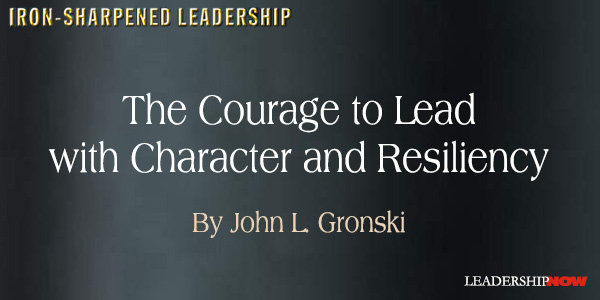
TAKING ON A POSITION of leadership comes with assuming risk, encountering organizational challenges, and being a moral role model for an organization. I believe a person who is not willing to make the sacrifice to take on such a role should step aside and let someone else do it. Three attributes that are critical to taking on the mantle of leadership are decision-making, resiliency, and character. Leaders must have the courage to make decisions with well less than perfect information. Jack Welch, who led General Electric as its CEO from 1981 to 2001observed that mid-level leaders at GE struggled with having the courage to make a decision. Rarely does a leader have the luxury of making a decision with 100% of the information available. Still, a leader must decide. If a leader waits while trying to gain perfect information, he or she will lose an opportunity. Leaders who have led organizations for almost any period of time all have one thing in common. They have had to face adversity at some point and guide the organization through challenging waters. This takes resiliency on the part of a leader, and it takes a leadership approach that helps build resiliency among the team and the organization itself. Character is the foundation of leadership. Although toxic leaders might achieve some success over the short term, it is character-based, servant leaders with strong values who gain sustained success and results. Escape To Freedom A soldier I met at a Vietnam War commemoration ceremony several years ago has a story that exemplifies decision-making, resiliency, and character in spades. As I mingled with members of the crowd at the ceremony, I happened upon a man that was wearing a U.S. Army dress uniform. He wore the rank of Chief Warrant Officer 3 and had pilot wings on his chest. I asked if he had served in Vietnam and he gave me a curious answer. He said he served in Vietnam but not as a U.S. Soldier. He explained that as a soldier in the South Vietnamese Army he fought alongside the U.S. Army, flying UH-1 helicopters. The UH-1 helicopter is also known more affectionately as the Huey. CW3 Chieu Le then went on to tell me the rest of his story. He was in Saigon on April 30, 1975, the day the U.S. Embassy in Saigon fell. Since he fought alongside U.S. Forces, he knew that if he were captured by North Vietnamese soldiers entering the city he would be put to death or severely tortured. He made a decision. He fired up a Huey helicopter. By the time he began to lift off the ground about 20 others were clinging to the helicopter as it sputtered into the air. Le had no flight plan and really no idea where to fly to. This was not a pre-planned mission, and no one designated a route or objective. His intent was to succeed, not to fail, even though this was an extremely risky venture. As he applied power to the engine of the chopper, he whispered a prayer to his higher power to mitigate the risk. He began flying east over the South China Sea. He could not hide his anxiety as he talked into the radio handset, he held in the palm of his sweating hand. He began to transmit over the radio as he watched the South China Sea pass below him. He used the distress call that first originated at Croydon Airport in London in 1921 and that is still used today. Le called out, “Mayday, mayday!” He followed by letting whoever he hoped was listening know that he was the flight of freedom. He called out over and over, “Mayday, mayday, this is the flight of freedom.” He could see the needle on his fuel gauge point closer to empty as he flew over the endless sea below. Finally, he received a reply. It was the USS Midway, conducting operations in the northern area of the South China Sea. The Midway vectored Le and the passengers he carried toward the ship and Le hit the carrier deck harder than he expected with his chopper literally flying on fumes. As he exited his helicopter Le wanted to hug every crew member on that ship. The ship’s crew escorted Le to a bunk so he could get some rest. As he drifted off to sleep, Le made sure he thanked that same higher power he prayed to as he began his flight of freedom. Le made his way from the Midway to a refugee camp in Austria, then to a refugee camp in Arizona, and finally, he made his way to a refugee camp at Ft. Indiantown Gap, Pennsylvania. It was in Pennsylvania that he put roots down. He joined the Pennsylvania Army National Guard and was proud to wear the uniform of the country he had fought alongside in southeast Asia. He became qualified to fly the Huey again and rose to the rank of Chief Warrant 3 before he retired from the military with well over 20 years of faithful service. Le is a leader who made a courageous decision when the outcome was uncertain. He proved to be resilient, not only during his flight of freedom, but afterward as he made his way from one refugee camp to another. He continuing to show the positive energy, fitness, and spirit of vulnerability that allowed him to overcome challenges that probably would have been too much for many others to bear. Finally, he demonstrated strong character and values. He cared about others as evidenced by the risk he took to fly over 20 other people to safety on that fateful day in April 1975. But there is another element to this story and that is the necessity of “team.” Although it might appear that Le accomplished a great feat alone, he will be the first to tell you that is not the case. He will tell you the back story about the maintenance crew that had prepared his Huey, so it was able to make the audacious flight. The crew on the Midway answered his distress call and then calmly guided him in and assisted with his landing on the deck of the carrier as the fuel tank on his helicopter ran dry. There were teams at the refugee camps who provided for his basic needs. Finally, he was able to join one of the finest team of teams in the Pennsylvania Army National Guard. Ultimate success is never about one person, but it is about a team working together to bring a vision to a successful conclusion. The story of Le’s escape toward freedom and his accomplishments afterward is a story of courage, resiliency, and character that all leaders would do well to learn from. Le had the courage to lead.  
Posted by Michael McKinney at 08:33 AM
08.12.21

Leading Thoughts for August 12, 2021
IDEAS shared have the power to expand perspectives, change thinking, and move lives. Here are two ideas for the curious mind to engage with: Mark C. Thompson and Bonita S. Thompson on taking action in a crisis: “Challenges don’t come neatly packaged the way we planned them. So when you’re taken by surprise—and you don’t have the tools or support that you’d counted on—the first thing to think about is not what you’ve lost but what tools you still have. Start where you are. Figure out what you do have and use that to your advantage. When in doubt, take stock and then take action. Source: Admired: 21 Ways to Double Your Value John Wooden on self-control: “Leadership starts with self-control. Remember, control of your organization begins with control of yourself. When you lose control, you sanction the same behavior for those under your leadership—the team. There is never an excuse for violating this imperative, and when you do, your credibility and consistency as a leader diminish accordingly.” Source: Wooden on Leadership Look for these ideas every Thursday on the Leading Blog. Find more ideas on the LeadingThoughts index.
Posted by Michael McKinney at 07:58 AM
08.10.21

How to Change
YOU WANT TO CHANGE, but the problem is you haven’t found the right strategy. You need to outsmart your issues. In How to Change, behavioral scientist Katy Milkman says we need to tailor our approach to fit the obstacle and our circumstances. We search for solutions that will deliver the quick knockout victory and tend to ignore the specific nature of our adversity. The surest path to success is not one-size-fits-all. Instead, you must match your approach to your opponent. You’ll get further faster if you customize your strategy: isolate the weakness preventing progress, and then pounce. Whether internal or external, the key to change is understanding your opponent—the obstacle. Milkman takes a look at seven of those obstacles. Change is easier when you have a blank slate with no old habits working against you. This is often not possible, but you can create the feeling of a blank slate. Life events, anniversaries, or new chapters in your life can signal a clean slate. “These new chapters are moments when the labels we use to describe ourselves, who we are, and what we’re living through shift, compelling us to shift with them…. And labels matter to our behavior.” There is a downside to fresh starts. If you are doing well, a fresh start can be an interruption and become a setback. If you are doing poorly, the disruption can work to your advantage. A fresh start is just that. To maintain that motivation to change, you will need to consider other obstacles that will tempt you to quit. Once you begin, the present temptations can loom larger than the long-term rewards of sticking to your goal. One strategy is to bundle your temptation with an activity that you are trying to avoid—like binge-watching TV while exercising. Another strategy is to make your change initiative fun by adding rewards, a sense of competition, and leaderboards. Milkman notes, however, “gamification works when players ‘buy in’ to the game. It can backfire if players feel the game is being imposed on them.” When we feel like putting off the change, a commitment device can be just the thing to overcome procrastination. A cash incentive (or rather a disincentive) can be very effective. Commitment devices “help us change our behavior for the better by locking us into choices we make when we’re clearheaded about what’s good for us, not when we’re hotheadedly reacting to an imminent temptation, and they keep us from indulging in the temptation to misbehave later on.” Stuck in our routines, it is easy to forget to do those out-of-the-ordinary things we want to do. We often resort to reminders, but the timing has to be just right, or we forget those too. Reminders work best when we can act on them immediately. The strategy here just may be implementing cues—linking the desired behavior to a specific clue that will remind us to act. “Often, when we make plans, we don’t focus on what will trigger us to act. Instead, we focus on what we intend to do.” So, fill in the blank: “When ______ happens, I’ll do ______.” “While any cue is better than no cue, it’s best to rely on clues that are out of the ordinary.” Some changes never make it out of the gate because we just don’t feel like it. We’re lazy. “When faced with repeated decisions, laziness is harder to tackle.” So, we need to form new habits. Duh. But there are ways to help you make that happen. One important way is to build flexibility into your schedule. “Forming stable routines is key to habit formation. But if we want to form the ‘stickiest’ possible habits, we also need to learn how to roll with the pinches, so we can be flexible when life throws us a curveball. Too much rigidity is the enemy of a good habit.” Milkman also recommends we should aim for streaks by tracking our efforts. Tracking helps you “avoid forgetting to do it until it becomes second nature.” A lack of confidence also thwarts our change efforts. “Research confirms the obvious: when we don’t believe we have the capacity to change, we don’t make as much progress changing.” It is natural to give people who are struggling advice, but it also tends to lower their confidence. Instead, try asking them to give advice to someone in their situation. “Encouraging someone to share their wisdom conveys that they’re intelligent, capable of helping others, a good role model, and the kind of person who succeeds. It shows that we believe in them.” When trying to make a change, seek out others doing what you are trying to do. Milkman calls this strategy “copy and paste.” “So if you want to get fit, tip books will surely help, but if you can spend some time with fit peers and watch out for ideas, you’ll likely do even better.” Since our peers heavily influence our choices, hanging out with people who are doing what we want to do provides some motivation and accountability. When the barriers to change are internal, the key to success is to tackle them with a tailored suit of solutions and to treat change as a chronic challenge rather than a temporary one. 
Posted by Michael McKinney at 10:35 PM
08.06.21

FYI: Your Chaotic Story Is an Asset — So Share It!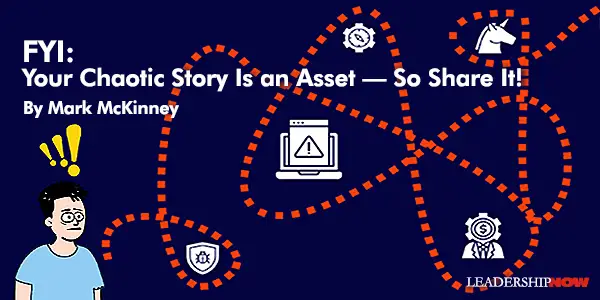
IF YOU’RE LIKE ME, you worry about your startup’s story — or rather presenting it. The pivots, founder feuds, competitors, and development delays are just some of the many hairpin turns that contort your journey into something much more…free-spirited. You and I have realized that we need to strategically and positively frame our stories to raise a successful funding round. Yet, our startup stories can sometimes seem so chaotic that we might mentally predict failure — how on earth can our messy story look appealing? Who would want to get involved in that? We may even begin envying companies with a seemingly more linear (as far as we can tell) storyline. But regardless of our perceptions, the chaotic story you have can actually be an overwhelming advantage if played correctly. Let’s take a look at this extreme example. Enter Jon Medved, the CEO and founder of an Israeli startup fund called OurCrowd. In 2012, Medved was in the process of courting OurCrowd’s first investors. These two New Yorkers had never been to Israel before, so Medved decided to show them around Tel Aviv and introduce them to Israel’s startup landscape. After having an enjoyable afternoon of touring and meeting local entrepreneurs, Medved and his guests were on a highway back to Jerusalem when the sound of spine-chilling air raid sirens began to howl. Rocket attacks on Tel Aviv had just begun, the first attack in twenty years. I pulled over to the hard shoulder and directed my guests to lie down in the dirt by a wall as Israel’s Iron Dome defense system soared into action over our heads. We heard the booms as Iron Dome intercepted the Iranian Fajr missiles overhead, and felt the sickening impact as three of the rockets fired by Hamas exploded a couple of miles from where we were taking cover. After the assaults ceased and sirens fell silent, Medved and the two investors climbed back into the car. On the drive back, Medved had the sickening feeling that the successful day had just been completely ruined — who in their right mind would invest in companies that were threatened by missile attacks? Upon arriving home, the two investors informed Medved that they would reconsider their investment proposal and get back to him tomorrow morning. When I arrived at the hotel the following morning, the investors had already made up their minds. I opened my mouth to speak but one of them stopped me short. Woah. Imagine being told that your company will not only receive the funding it needs but double the amount because of the hardships you’re enduring. Wouldn’t that make you a little prouder of the obstacles you’ve overcome and are overcoming? I think we often get caught up in keeping our journey as neat and as straightforward as possible at the expense of missing the opportunity to demonstrate how strong we really are. Thus, we try to minimize and skip crucial hurdles instead of giving them proper attention — giving how you overcame and progressed forward its proper attention. This isn’t to say that you need to go into gory detail about every embarrassment and roadblock — don’t do that — but you should discuss the highlights of the arduous journey you and your team have traveled. Such a journey demonstrates that you’ve got skin in the game and, most importantly, that the next time an ugly debacle comes your way, you won’t run and let the company fold. Because of your nonlinear journey, you and your team are seasoned warriors unphased by chaos. Just as those Israeli companies turned managing the daily threat of missile attacks into a strength inspiring to investors, so can you with your startup’s journey. As VC Mark Suster said of investors, “it takes a miracle to get investment dollars out of them if they’re not impressed with the team.” A difficult journey that your team has persisted through will impress them. It’s up to you to share it. 
Posted by Michael McKinney at 08:51 AM
08.05.21

Leading Thoughts for August 5, 2021
IDEAS shared have the power to expand perspectives, change thinking, and move lives. Here are two ideas for the curious mind to engage with: John Maxwell on how adversity introduces us to ourselves: “Adversity always gets our attention. We can’t ignore it. It causes us to stop and look at our situation. And at ourselves if we have the courage. Adversity creates an opportunity for self-discovery. As the great Egyptian leader Anwar el-Sadat said, ‘Great suffering builds up a human being and puts him within the reach of self-knowledge.’” Source: Leading in Tough Times Retired General Ronald Yates on the American tradition of total quality leadership: “During the American Revolution, an officer in civilian clothes rose past a group of soldiers busy repairing a small fortification of rocks and tree limbs. Their commander was shouting instructions but making no attempt to help them. When the passer-by asked the commander why he wasn’t helping, the man in charge replied with great dignity, ‘Sir, I am a corporal!’ Source: Total Quality Leadership: An American Tradition, Speech delivered November 1, 1994 Look for these ideas every Thursday on the Leading Blog. Find more ideas on the LeadingThoughts index.
Posted by Michael McKinney at 07:16 AM
08.03.21

Overriding Our Instincts in Order to Become Caring Leaders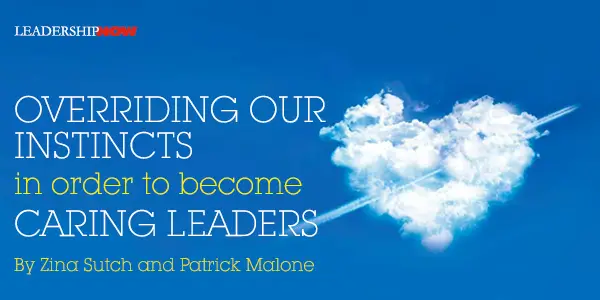
WE OFTEN THINK of ourselves as good leaders — or at least somewhat good. Afterall, we got this far in our careers by following our instincts, practicing what we learned, and applying appropriate business strategies. But are we leading? Truly leading people? Before we answer that question, let’s think about what’s really happening. Over the course of a career, we gain a myriad of tools and tips on how to lead. It’s easy for us to deduce that implementing everything we’ve learned has gotten us where we are now. We follow the acronyms, rules, and checklists we’ve learned from the innumerable books we’ve read, classes and symposiums we’ve attended, and mentors whose wisdom we’ve sought. We rely on this vast collection to get us through the daily challenges. Let’s call this methodology what it is: a recipe for leadership. We seek these quick fixes to leadership dilemmas like we’re shopping on Amazon.com and expecting next-day delivery, especially if we’re new leaders. Perhaps it’s because as managers, we face a horde of challenges. Bottom-line pressures, competitive marketplaces, and maybe a little self-doubt. We’re forced into decisions that answer a time crunch but do little to nurture high-performing organizational cultures. So, we rely on the leadership recipe. This “formula for leadership” approach occurs at all levels. Executives at the highest level of the company are quick to check the big boxes. Did I send out a monthly newsletter? Did I host a strategic planning offsite or a town hall? Did I say hello to a stranger in the cafeteria? Mid-level directors and managers don’t fare well either. They’re focused on getting the job done, meeting deadlines, analyzing data, and meeting quarterly performance goals. They rely on instincts, while the organization’s culture continues to support mediocre performance. Our brain loves the recipe approach. The human brain is a miracle of survival and, from a psychological and evolutionary perspective, this makes sense. We have a human need for steadiness and predictability. We like consistency. When the brain performs its neural magic, it creates a pathway that can quickly become our default way of thinking. The result is the brain is very comfortable with the knowledge it’s already mastered. These neural pathways and leadership formulas make us feel safe, and we become comfortable and confident with our expertise. We trust what we know, and we shun new ways of thinking. Recipes are, by definition, detailed processes that allow us to get to a final product — and voila, mission accomplished. They’re at least partially designed to reduce uncertainty and stress. And while they admittedly have some value, they don’t account for the human aspects that yield high performance. They don’t have an answer for how to build an emotional connection with the people that we lead. To accomplish that as leaders, we must stray from our comfort zone, override those instincts, and start caring. Really caring, not just saying that we do. Veering from our path of coziness makes us feel unsafe and vulnerable. Straying into the uncertainty of caring is uncomfortable. But when we fail to do this as leaders, we fall short of what leadership really is — letting go and getting real. True leaders are about inspiration, not expertise. Relying on past prescribed practices relinquishes us to stay on autopilot. We have no authentic connection to those we lead. Taking an exit ramp from those instincts and the recipe approach may be the most meaningful step we’ll ever take towards really leading. Here’s how to make that swerve: 1. Start with self-reflection. Challenge yourself to expand your thinking capacity. Begin with mindfulness or meditation exercises that allow you to descend deep within yourself to assess what’s really important to you. As you become more comfortable with who you are, you’ll become more approachable and connected with others. 2. Try something completely new. Take a pottery course or learn to play an instrument. Read more fiction and let your mind wander. This will help your brain develop new neural conduits that expand the way you think and the way you experience the world. This exercises the imaginative portions of the brain and opens doors to prospective solutions. 3. Let go of the control you think you have. Do you have millennials working for you? Here’s a shocker: you don’t control them. Actually, you don’t really control anyone. If this is your bag, you aren’t leading, you’re coercing, and your employees will give you their bare minimum effort. In today’s competitive business world, we need the discretionary energy your employees and teams hold. 4. Take a fourth-person perspective. Far too often, we congratulate ourselves on taking a third-person perspective on a problem. We pretend that we can see it through someone else’s eyes. Try looking at yourself looking at a problem and ask yourself what biases and tendencies you’re carrying and what you can do differently. 5. Embrace positivity. Leadership recipes can’t guide your attitude, nor can they influence how you see the world. Try to view your role as a leader through a positive lens — one that assumes noble intent, seeks the best in people, and presents an optimistic view about the future. Your employees aren’t the problem. They’re the answer to your problem. Fashion optimistic environments where people feel engaged and where they trust one another. If it sounds like this is work, it is. When we take a step away from prescribed approaches to leading, we step into a world that’s full of doubt and risk. We enter a universe where human emotions can vary greatly, and we’re left to deal with them. We may be hardwired for survival, but we’re also hardwired for belonging — to create a sense of connection with others. One size doesn’t fit all. Take a step beyond the recipe, override that instinct, welcome the human aspect of leadership, and become a truly caring leader.  
Posted by Michael McKinney at 10:36 AM
08.01.21

First Look: Leadership Books for August 2021Here's a look at some of the best leadership books to be released in August 2021. Don't miss out on other great new and future releases not listed here.
Do you wish you could stop the mayhem of work and life and just take a minute? Do you sense you could contribute more if there were a little more room in the day? Does busyness deprive you and your burnt-out team of the oxygen your talents need to catch fire? Many have felt that way, yet taking a pause has seemed impossible—until now. Juliet shows all of us how to reclaim time for thinking and make room for what truly matters. Whether you are an individual trying to build a more sane and humane flow of daily work, a team that wants new levels of efficiency and effectiveness, or an entire organization changing your culture toward thoughtfulness, this book will lead you there.
Will the next rogue wave sink your ship―or will you choose to profit from it? At this moment, rogue waves are forming under your business. Emerging technologies, changing demographics, the data economy, automation, and other trends―the undercurrents of radical, systemic change―are crashing into each other. When they converge, they’ll produce sea changes that sink companies and wash away entire industries overnight. If your competitor can’t ride out the next wave and you can, you win. In Rogue Waves, Jonathan Brill―a renowned expert on resilient growth and decision making under uncertainty―shows you how to prepare your business to survive and thrive through the most radical upheavals.
Discover eight powerful mindset shifts that enable leaders and seekers of all ages to thrive in a time of unprecedented change and uncertainty. Being adaptable and flexible have always been hallmarks of effective leadership and a fulfilling life. But in a world of so much—and faster-paced—change, and an ever-faster pace of change, flexibility and resilience can be stretched to their breaking points. The quest becomes how to find calm and lasting meaning in the midst of enduring chaos. A world in flux calls for a new mindset, one that treats constant change and uncertainty as a feature, not a bug. Flux helps readers open this mindset—a flux mindset—and develop eight “flux superpowers” that flip conventional ideas about leadership, success, and well-being on their heads. They empower people to see change in new ways, craft new responses, and ultimately reshape their relationship to change from the inside out.
Too Proud to Lead provides essential advice on how to avoid that hubristic behavior that can endanger businesses, as well as cope with arrogant overconfidence in others in the workplace. Laying out the dangers of arrogant overconfidence for both individuals and organizations, Too Proud To Lead explores the economic and psychological costs of hubristic behaviour and argues for a new approach to leadership in order to avoid the pitfalls of hubris. The authors reveal exactly how confidence can sour into overconfidence--and why it can happen to anyone. With this easily-absorbed book, packed with checklists and key insights, readers acquire the essential arsenal of tools for understanding, identifying, anticipating and coping with hubris, in both themselves and in the workplace, leading to better lives and sustained success for years to come.
Be energized, but not overwhelmed. What’s the most pressure you’ve ever been under? How did you react? What helped? What didn’t? Over the past five years, Dane Jensen has asked these questions of thousands of high performers—from Olympic gold medalists to Navy SEALs, politicians, executives and busy parents. What has emerged from these conversations is that while everyone’s experiences under pressure are unique, pressure follows patterns and develops in predictable ways. If we can recognize the patterns, we can improve our ability to sidestep the biological traps that can sabotage us—and use the energy that accompanies pressure to thrive.
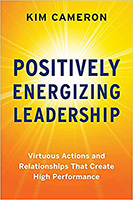 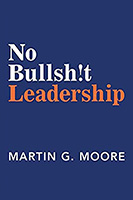 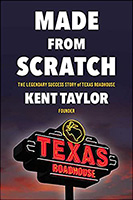
 Build your leadership library with these specials on over 28 titles. All titles are at least 40% off the list price and are available only in limited quantities. “Books are the carriers of civilization. Without books, history is silent, literature dumb, science crippled, thought and speculation at a standstill. Without books, the development of civilization would have been impossible. They are engines of change, windows on the world and lighthouses erected in the sea of time. They are companions, teachers, magicians, bankers of the treasures of the mind. Books are humanity in print.” — Barbara Tuchman
Posted by Michael McKinney at 06:27 AM
|
BUILD YOUR KNOWLEDGE


How to Do Your Start-Up Right STRAIGHT TALK FOR START-UPS 
Grow Your Leadership Skills NEW AND UPCOMING LEADERSHIP BOOKS 
Leadership Minute BITE-SIZE CONCEPTS YOU CAN CHEW ON 
Classic Leadership Books BOOKS TO READ BEFORE YOU LEAD |
|